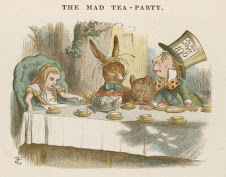It is a conceit of duopolist ideology that the bipoligarchy mediates ideological extremes, resulting in centrist policy. It is even maintained that this is the "beauty of the two-party system," as
John Andrews put it at the Denver Post.
Bill O'Reilly re-packages the conventional wisdom, stating that one-party dominance . . .
is not really healthy for the USA, as a vibrant two-party system is needed in order to solve complex problems and prevent the arrogance and corruption of entrenched ideology.
In the present national context, these arguments are, of course, nothing more than (in)direct pleas for divided government and undivided support for the GOP. Obvious retorts aside, such calls would not ring so hollow were it not for the fact that most of the country already effectively live in a one-party state, that is, in non-competitive districts. A reader of Florida Today makes
the case against district rigging, otherwise known as redistricting:
Florida has been so brilliantly gerrymandered by the Republican Party that we have become a county and state with a one-party system. This can be corrected only if enough registered voters sign the petitions being circulated to have Florida redistricted [fairly].
However, the argument in favor of dismantling the duopoly's district rigging system is undermined by the author's appeal to authority. She continues:
Wouldn’t it be great to live in a two-party state? That’s the way our Founding Fathers intended it to be, reasoning that a two-party system would provide checks and balances, keeping one group of people from dominating the political system.
Of course the 'Founding Fathers' did not intend the US to devolve into a two-party state, nor is duopoly politics a check and balance in government. This misconception is not uncommon however, as noted here before (see, for instance,
duopoly unchecked, imbalanced). The mystification seems to have become a Republican talking point of late, in which the two-party system is intentionally confused with the constitutional separation of powers in a bid to score political points in the duopoly game. (Indeed, the
NYT opinion pages have even begun to catch on to the act.) A reader of Maine's Kennebec Journal
sets the record straight, however. Responding to an April editorial on the
GOP's implosion, he points out that . . .
the founders did not institute a two-party system . . . Unfortunately, the Democrats and Republicans have institutionalized their parties over the last 50 (or more) years. They have continuously taken steps to make "third party" participation more difficult. For example, restricting ballot access at all levels of government.
District rigging is yet another aspect of the duopoly machine's auto-institutionalization. The two-party one-party state does not check the concentration of power, it is rather the result of the concentration of power, the means by which one group of people, the bipoligarchy,
the victorious faction, dominate the political system.


3 comments:
Gerrymandering is one way that the Bipolarchy parties collaborate while competing. A typical practice is the creation of geographically absurd districts based on demographic concentration. This usually creates a guaranteed seat for the minority party (not to mention a minority group), but the intent is to strengthen the majority party's power in new districts that won't include hostile minority groups. Curiously, this sounds like an ideal way to further undermine the minority party by creating districts most likely to rally to an independent party, but somehow that never happens.
Fair Vote has a good amount of information on redistricting reform efforts on a state by state basis.
Gosh, there is so much effective material here!
Post a Comment